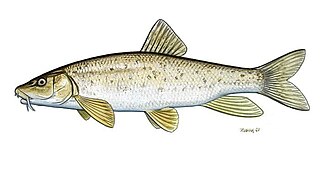
Barbus is a genus of ray-finned fish in the family Cyprinidae. The type species of Barbus is the common barbel, first described as Cyprinus barbus and now named Barbus barbus. Barbus is the namesake genus of the subfamily Barbinae, but given their relationships, that taxon is better included in the Cyprininae at least for the largest part.

Barbels are group of carp-like freshwater fish, almost all of the genus Barbus. They are usually found in gravel and rocky-bottomed moderate-flowing rivers with high dissolved oxygen content, known as the Barbel zone. A typical adult barbel can range from 25 to 240 cm in length and weigh between 200 g (7.1 oz) and 200 kg (440 lb), depending on species.
The Albanian barbel is a ray-finned fish species in the family Cyprinidae. It is often referred to as "Albanian barbel" in a literal translation of its scientific name.

The Iberian barbel is a ray-finned fish species in the family Cyprinidae. It is here placed in Luciobarbus following the IUCN, but that genus is very closely related to the other typical barbels and perhaps better considered a mere subgenus of Barbus. This large barbel can grow to over 50 cm (20 in) long.
Luciobarbus graecus is a ray-finned fish species in the family Cyprinidae. It is here placed in Luciobarbus following the IUCN, but that genus is very closely related to the other typical barbels and perhaps better considered a mere subgenus of Barbus. Found in and adjacent to Greece, its closest living relative seems to be L. lydianus, which is found in the northwest of Asia Minor.

Luciobarbus graellsii is a ray-finned fish species in the family Cyprinidae. It is here placed in Luciobarbus following the IUCN, but that genus is very closely related to the other typical barbels and perhaps better considered a mere subgenus of Barbus. The Andalusian barbel was formerly included in L. bocagei as subspecies.
Luciobarbus guiraonis is a ray-finned fish species in the family Cyprinidae. It is here placed in Luciobarbus following the IUCN, but that genus is very closely related to the other typical barbels and perhaps better considered a mere subgenus of Barbus.

Barbus haasi, or the Catalonian barbel or redtail barb Catalan: barb cua-roig; Spanish: barbo colirrojo or barbo de cola roja), is a species of freshwater fish in the family Cyprinidae.

Luciobarbus microcephalus is a ray-finned fish species in the family Cyprinidae. It is here placed in Luciobarbus following the IUCN, but that genus is very closely related to the other typical barbels and perhaps better considered a mere subgenus of Barbus.

Barbus peloponnesius is a ray-finned fish species in the family Cyprinidae. The western Balkan barbel is sometimes included in the present species.

The Andalusian barbel, also called gypsy barbel, is a freshwater fish species in the family Cyprinidae. It is here placed in Luciobarbus following the IUCN, but that genus is very closely related to the other typical barbels and perhaps better considered a mere subgenus of Barbus. The Andalusian barbel was formerly included in L. bocagei as a subspecies.
Barbus sp. 'Nzoia' is an undescribed but distinct freshwater fish species in the family Cyprinidae. It was first reported in 1999. A small African barb, it is provisionally assigned to the genus Barbus, but probably belongs – like similar species – in another genus.
Barbus sp. 'Nzoia 2' is an undescribed but distinct ray-finned fish species in the family Cyprinidae. It was first reported in 1999. A small African barb, it is provisionally assigned to the genus Barbus, but probably belongs – like similar species – in another genus.
Barbus sp. 'Pangani' is an undescribed but distinct freshwater fish species in the family Cyprinidae. Apparently a close relative of the East African red-finned barb, it is currently under study for its formal description. Until then, this small African barb is provisionally assigned to the genus Barbus, but probably belongs – like "B." apleurogramma – in another genus.
Luciobarbus steindachneri is a species of cyprinid fish. It is here placed in Luciobarbus following the IUCN, but that genus is very closely related to the other typical barbels and perhaps better considered a mere subgenus of Barbus.
Clypeobarbus matthesi is a species of ray-finned fish in the genus Clypeobarbus from the Congo Basin.
The Simav barbel is a species of ray-finned fish in the genus Barbus, it is found in the southern Marmora basin in Turkey, in the Simav and Gönen drainage systems.

The Romanian barbel is a species of ray-finned fish in the genus Barbus. It occurs in the lower Danube basin of Bulgaria and Romania, as well as in several rivers of Bulgaria flowing into the Black Sea, such as Kamchiya. The species is named after János Salamon Petényi.
Barbus strumicae is a disputed species of European cyprinid freshwater fish. It is found in Greece, Macedonia, and Bulgaria, in drainages of the Aegean Sea basin.

Tskaltsitela Gorge Natural Monument is a river gorge in western Georgia, in Tkibuli and Terjola municipalities. The historical and geographic name of this area of Georgia is Okriba. The main river in Okriba is the river Tskaltsitela, also spelled Tsqal-Tsitela. The river got its name from the reddish color of the water: tsqal means water and tsitela means red in Georgian. The water acquires its color by washing clays containing iron rust. Tskaltsitela Gorge Natural Monument is a stretch of the Tskaltsitela river canyon approximately from Gelati Monastery Bridge all the way to Godagani Bridge at an elevation of 130–200 meters above sea level.










